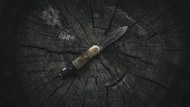A History of Knives: Regional Origins of the World’s Best Blades
Posted by American Edge on Apr 23rd 2020
Throughout history, certain areas of the world have been recognized and well known for their ability to design and make the most influential knives. Some are short-lived trends among their areas, others last through centuries of collectors, survivalists, and military personnel.
From ancient Japanese and Scandinavian styles up to the modern era, certain areas of the world are still well-known for making the very best blades.
Japan:
When you think of Japanese blades, you might think of Samurais and katanas, but Japan is well-known for all types of master cutlery. A Higonokami (also called a Higo knife) is a traditional Japanese pocket knife first produced in 1896. This was around the time of the industrial revolution in Japan when Samurai were relieved of their military duties and turned to making more conventional weapons for the public.
Also known well for chefs’ knives and cleavers, Japan has produced kitchen cutlery found in some of the most prestigious kitchens around the globe. Shun Cutlery collections are among the best in the world and widely adored by chefs.
Philippines:
Known to have a bit of a bad reputation, the Philippines is the birthplace of the Balisong (or butterfly knife) Illegal in many states in the U.S., it has been a popular style for over a thousand (yes, a thousand) years because it is quick and easy to open with one hand. Although, some speculation is put around the true origins of the knife.
Some say the knife originated in Europe (mainly France) between 1500 and 1700 and was then taken to the Philippines by European explorers. Though still others say the European version was used in much different ways and can’t be called the same knife. One thing that cannot be contested is that it is one of the most common self-defense blades around the world.
France:
The douk-douk is a French knife originally intended as a utility blade for working men. It is a simple slip joint knife with no locking mechanism and a handle traditionally made from sheet metal. Because the douk-douk was so popular, it was adopted as a service weapon in the French military and soon developed a reputation as an assassin’s weapon of choice.
Switzerland:
Even among knife novices, theSwiss Army Knife is popular around the world, gracing the backpacks of campers and junk drawers of housewives alike. Originating in Ibach, Switzerland, this knife was originally designed for soldiers to open canned food and disassemble their rifles. Now, there are “Swiss” army knife varieties all over the world that you can use to pull a splinter, open a bottle of wine, tighten a screw, and, yes, use as a pocket knife.
North America:
Made famous by Jim Bowie– famous knife fighter who died at the Alamo– the Bowie Knife’s history is actually quite blurry. This is mostly because a wide range of blade sizes and shapes can call themselves Bowie knives. The knife Jim Bowie became known for wasn’t actually one knife, but several he altered over a number of years. The original blades he and his brother commissioned had design inspirations from Spain, the Mediterranean, the old southwest, and South America. Perhaps it’s this mix of cultures and blending of regional inspirations that makes this American style so popular
Another Popular American style, the Buck knife was first produced in San Diego , CA by Hoyt H. Buck and has continued the tradition through five generations. Buck knives are traditionally sporting and field knives. They were credited with inventing the folding hunting knife style. Many knives with the characteristic are often called “buck” knives, even if not representations of the brand. However, just like not all tissues are Kleenex, not all folding hunting knives are Buck knives.



